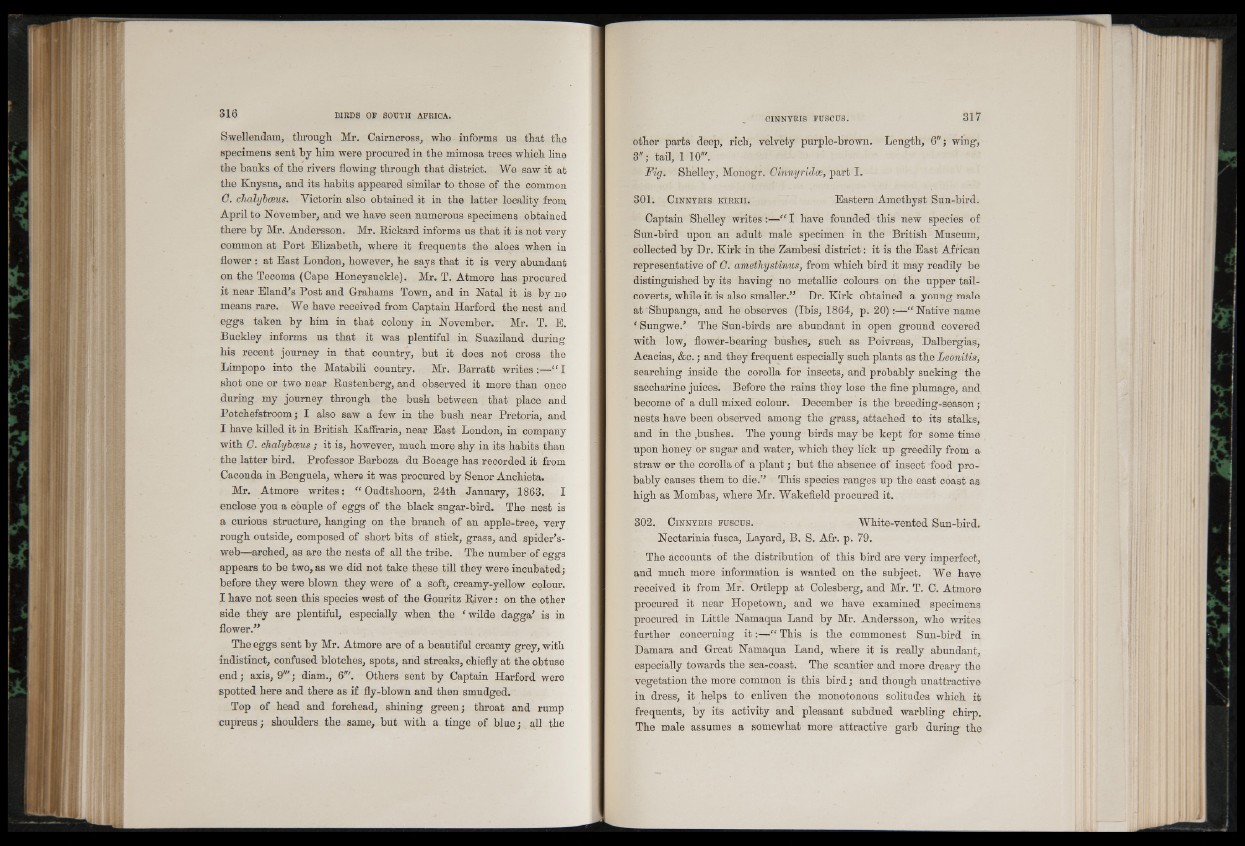
Swellendam, through Mr. Cairncross, who informs us that the
specimens sent by him were procured in the mimosa trees which line
the banks of the rivers flowing through that district. We saw it at
the Knysna, and its habits appeared similar to those of the common
G. chalybceus. Victorin also obtained it in the latter locality from
April to November, and we have seen numerous specimens obtained
there by Mr. Andersson. Mr. Rickard informs us that it is not very
common at Port Elizabeth, where it frequents the aloes when in
flower : at East London, however, he says that it is very abundant
on the Tecoma (Cape Honeysuckle). Mr. T. Atmore has procured
it near Eland’s Post and Grahams Town, and in Natal it is by no
means rare. We have received from Captain Harford the nest and
eggs taken by him in that colony in November. Mr. T. E.
Buckley informs us that it was plentiful in Suaziland during
his recent journey in that country, but it does not cross the
Limpopo into the Matabili country. Mr. Barratt writes:—“ I
shot one or two near Rustenberg, and observed it more than once
during my journey through the bush between that place and
Potchefstroom; I also saw a few in the bush near Pretoria, and
I have killed it in British Kaflraria, near East London, in company
with G. chalybceus ; it is, however, much more shy in its habits than
the latter bird. Professor Barboza du Bocage has recorded it from
Caconda in Benguela, where it was procured by Senor Anchieta.
Mr. Atmore writes: “ Oudtshoorn, 24th January, 1863. I
enclose you a couple of eggs of the black sugar-bird. The nest is
a curious structure, hanging on the branch of an apple-tree, very
rough outside, composed of short bits of stick, grass, and spider’s-
web—arched, as are the nests of all the tribe. The number of eggs
appears to be two, as we did not take these till they were incubated;
before they were blown they were of a soft, creamy-yellow colour.
I have not seen this species west of the Gouritz River: on the other
side they are plentiful, especially when the ‘ wilde dagga’ is in
flower.”
The eggs sent by Mr. Atmore are of a beautiful creamy grey, with
indistinct, confused blotches, spots, and streaks, chiefly at the obtuse
end; axis, 9'"; diam., 6"'. Others sent by Captain Harford were
spotted here and there as if fly-blown and then smudged.
Top of head and forehead, shining green; throat and rump
cupreus; shoulders the same, but with a tinge of blue; all the
other parts deep, rich, velvety purple-brown. Length, 6"; wing,
3"; tail, 1 10'".
Fig. Shelley, Monogr. Cinnyridce, part I.
301. C in n y r is k ir k i i . Eastern Amethyst Sun-bird.
Captain Shelley writes:—“ I have founded this new species of
Sun-bird upon an adult male specimen in the British Museum,
collected by Dr. Kirk in the Zambesi district: it is the East African
representative of G. amethystmus, from which bird it may readily be
distinguished by its having no metallic colours on the upper tail-
coverts, while it is also smaller.” Dr. Kirk obtained a young male
at Shupanga, and he observes (Ibis, 1864, p. 20):—“ Native name
‘ Sungwe.’ The Sun-birds are abundant in open ground covered
with low, flower-bearing bushes, such as Poivreas, Dalbergias,
Acacias, &c.; and they frequent especially such plants as the Leonitis,
searching inside the corolla for insects, and probably sucking the
saccharine juices. Before the rains they lose the fine plumage, and
become of a dull mixed colour. December is the breeding-season;
nests have been observed among the grass, attached to its stalks,
and in the .bushes. The young birds may be kept for some time
upon honey or sugar and water, which they lick up greedily from a
straw or the corolla of a plant; but the absence of insect food probably
causes them to die.’’ This species ranges up the east coast as
high as Mombas, where Mr. Wakefield procured it.
302. C in n y r is fu scu s . White-vented Sun-bird.
Nectarinia fusca, Bayard, B. S. Afr. p. 79.
The accounts of the distribution of this bird are very imperfect,
and much more information is wanted on the subject. We have
received it from Mr. Ortlepp at Colesberg, and Mr. T. C. Atmore
procured it near Hopetown, and we have examined specimens
procured in Little Namaqua Land by Mr. Andersson, who writes
further concerning i t :—“ This is the commonest Sun-bird in
Damara and Great Namaqua Land, where it is really abundant,
especially towards the sea-coast. The scantier and more dreary the
vegetation the more common is this bird; and though unattractive
in dress, it helps to enliven the monotonous solitudes which it
frequents, by its activity and pleasant subdued warbling chirp.
The male assumes a somewhat more attractive garb during the